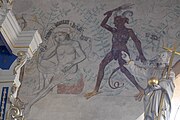Secco painting
The Secco painting (also Sekkomalerei or dry painting ) of Italian a secco ( on dry ) has a technique of mural .
In contrast to painting affresco , painting is not done on the fresh, still damp lime plaster, but on the already dry plaster or on the dry masonry. The secco techniques include glue , casein , emulsion, and oil and resin painting.
In the German-speaking world, all wall paintings are often referred to colloquially as frescoes, without reference to the production method.
In the Middle Ages, mainly lime, casein and tempera paints were used, later also oil and silicate paints . Lime and casein paints do not require any pre-treatment of the plaster, as is required with other techniques. In the art-historical epoch of the Romanesque this technique was used most frequently.
In contrast to the frescoes painted on damp plaster, Secco paintings are less durable because they do not bond to the subsurface to such an extent. A famous example of a badly damaged Secco painting is " The Last Supper " by Leonardo da Vinci in the refectory of the Dominican monastery of Santa Maria delle Grazie in Milan (15th century).
Outside Europe you can find Secco paintings e.g. B. in Asia as Tibetan Buddhist wall paintings .
Examples of Secco paintings in German-speaking countries
- Brunswick Cathedral , Lower Saxony (13th century)
- Lambrecht Monastery , Rhineland-Palatinate, Gothic Secco painting (14th century)
- Evangelical town church Zierenberg , Hesse (14th and 15th centuries)
- Saint Lukas Church in Mühlberg, Thuringia (15th century)
- St. Mary's Church in Herzberg / Elster, Brandenburg (15th century)
- Fortified church St. Walburga in Bad Steben, Bavaria (16th century)
- St. Wolfgang Church in Hünenberg, Switzerland (16th century)
- Castle chapel of Kriebstein Castle , Saxony (15th century)
Web links
- Secco as a painting technique on plaster on: Maler.org
Individual evidence
- ↑ Kurt Wehlte: Materials and Techniques of Painting. Otto Maier Verlag Ravensburg, unchanged reprint of the 4th edition 1981, 1996, ISBN 3-473-48359-1 , p. 243.
- ↑ Albert Knoepfli; Oskar Emmenegger: Wall painting up to the end of the Middle Ages. In: Reclam's Handbook of Artistic Techniques, Volume 2, Wall Painting and Mosaic. Philipp Reclam jun., Stuttgart, 1990, ISBN 3-15-010345-2 , p. 24.
- ^ Secco paintings in the Evangelical City Church in Zierenberg






